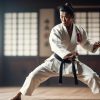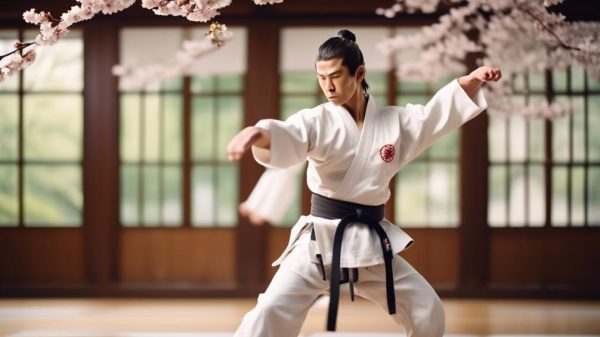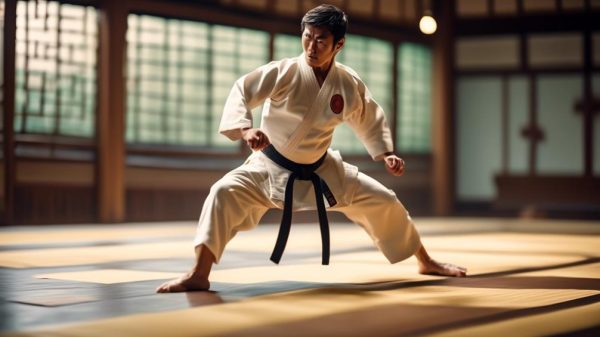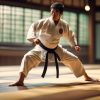As the second part of the Naifanchin trilogy performed in Shito-Ryu Karate, Naifanchin Nidan builds upon fundamental concepts from Naifanchin Shodan.
The embusen or floorpath intensifies with the addition of backwards steps and turns as students react to attacks from all angles.
Containing 16 total movements, Naifanchin Nidan combines high and low knife hand blocks into the signature X-shaped arm positioning for defense.
Augmenting the rooted cat leg stances, offensive techniques introduce palm heel strikes, backfists, elbow strikes and spear hand thrusts targeting vital points.
This Naifanchin Nidan explanatory guide diagrams the sequence and provides photographed demonstration of proper form.
Compare video to correct chambering, hip rotation, pivot steps and striking extension.
Regular practice hones battled-tested techniques against surround assaults – an excellent kata for self defense.
Origins of Naifanchin Nidan
The rich history of Naifanchin Nidan kata in Shito-Ryu Karate reflects a deep-rooted tradition of close-quarters combat techniques. This kata, also known as Naihanchi Nidan, holds a significant place in training, offering insights into traditional fighting methods honed over time. The fundamental principles it embodies—core stability, controlled breathing, and precise body mechanics—speak volumes about its origins.
It’s important to note that the movements in Naifanchin Nidan kata aren’t universally standardized. Variations exist across different Shito-Ryu schools, and mastering the kata requires not only learning the movements but also understanding their underlying intent. Seeking guidance from your instructor is crucial, as each school may interpret the kata with subtle yet significant differences.
Instead of viewing the kata’s diversity as a complication, embrace it as a strength. Exploring the origins of Naifanchin Nidan will strengthen your foundation, enhancing your physical and mental attributes.
Each movement in the kata represents a dialogue with history—a connection between you and the generations of karateka who’ve shaped Shito-Ryu into the formidable art it’s today.
Significance in Shito-Ryu
Shito-Ryu practitioners greatly value the Naifanchin Nidan kata as it plays a pivotal role in honing their martial skills. This kata, with its intricate patterns and deep historical roots, serves as a cornerstone for those seeking mastery in Shito-Ryu.
It’s essential to understand the broader significance of the Naifanchin Nidan within the tapestry of Shito-Ryu Karate, a style renowned for having the most katas among major Karate traditions.
Each movement within the Naifanchin Nidan kata holds significance beyond mere gestures; it forms the foundation for developing impeccable technique, balance, and focus.
It’s vital for practitioners to adapt to their specific Shito-Ryu lineage’s kata, as variations exist between different schools and organizations.
Seeking guidance from your instructor is crucial to refine the precise movements and nuances that define your practice.
It’s important to recognize that katas like Naifanchin Nidan aren’t just forms but repositories of combat wisdom; every stance, strike, and block serves a distinct purpose.
Furthermore, the practice of bunkai, which involves breaking down offensive and defensive applications, transforms the Naifanchin Nidan from a ceremonial pattern into a practical arsenal.
Key Postures and Movements
Understanding the significance of Naifanchin Nidan’s power lies in the seamless transition of stances, balancing stability with fluidity.
Each movement, whether it’s a block or strike, possesses a distinct characteristic that demands thorough deconstruction and dedicated practice for mastery.
Perfecting these elements goes beyond mere repetition; it involves internalizing the kata’s cadence and purpose.
Stance Transition Dynamics
Understanding the fluid movement between stances in Naifanchin Nidan is essential for mastery. This involves a clear comprehension of the distinct mechanics of each posture and the precise distribution of weight.
In the Shito-Ryu kata, the dynamics of transitioning between stances extend beyond mere stepping; they encompass the seamless flow of movement, emphasizing stability and balance during shifts.
Proper body alignment is crucial during transitions, as any misalignment can disrupt momentum and effectiveness.
Attuning to the nuances of weight distribution is key, allowing practitioners to feel the grounded energy in their stances.
Valuable guidance from instructors fine-tunes technique and ensures that each transition is executed with precision.
Embracing these dynamics enables practitioners to embody the spirit and power of Naifanchin.
Signature Technique Breakdown
Understanding the essence of Shito-Ryu Kata Naifanchin Nidan involves grasping its powerful stances and intricate movements, which are vital for mastery.
This kata, also known as Naihanchi, requires precision in every technique.
Your breakdown of signature techniques should reflect a deep understanding of the unique rhythm and flow of the kata.
To refine your execution, carefully analyze each movement, paying attention to the nuances that set this kata apart.
Engage with your instructor to discuss any particular movement that challenges or intrigues you. Keep in mind that interpretations of katas can vary, so personalized guidance is invaluable.
Supplement your hands-on training with visual aids to solidify the correct postures and transitions, ultimately enhancing your proficiency in this esteemed Shito-Ryu kata.
Step-by-Step Kata Breakdown
When breaking down the Naifanchin Nidan kata, it’s crucial to pay close attention to the intricate details of each technique.
Take the time to carefully analyze the sequence of movements, understanding the purpose and application behind every step.
Mastery comes from recognizing subtle nuances and consistently practicing with precision.
Kata Technique Details
When perfecting your Shito-Ryu Naifanchin Nidan kata, it’s crucial to break down the sequence into manageable steps and focus on the nuances of stance and posture to embody precision and elegance.
Each technique should exude natural power, and transitions should be both seamless and intentional.
Seek guidance from your instructor, especially in a style as meticulous as Hayashi-Ha Shito-Ryu.
Here’s a brief overview using a table highlighting key elements of the kata technique:
| Technique Element | Key Focus |
|---|---|
| Stance | Emphasize grounding and stability, particularly important for the Naihanchi-specific lateral movements. |
| Hand Position | Pay attention to precise hand placement to ensure effective strikes and blocks. |
| Breathing | Harmonize your breath with movements to achieve fluidity and strength. |
Movement Sequence Analysis
Understanding and mastering the movements of Shito-Ryu Kata Naifanchin Nidan requires a meticulous approach.
It’s essential to comprehend the purpose and technique of each movement with absolute clarity.
To achieve mastery in this kata, it’s crucial to ingrain the sequence deep into your muscle memory and execute each technique flawlessly.
Here’s how you can cultivate the spirit of a warrior:
- Visualization: Envision each technique in your mind with the vividness of a real fight.
- Precision: Every stance and strike reflects your unwavering dedication.
- Fluidity: Move with the grace and power of flowing water, unstoppable in your motion.
- Intensity: Every block acts as a shield, every punch as a spear.
Consult your instructor for detailed guidance and corrections to ensure precise analysis of the Naifanchin katas.
Diligent practice will integrate the kata into your very essence.
Common Mistakes to Avoid
When practicing Naifanchin Nidan, it’s important to steer clear of common pitfalls that may hinder your progress and technique in this Shito-Ryu kata.
| Common Mistake | Consequence | How to Avoid |
|---|---|---|
| Incorrect Execution | Weak technique and inaccurate movements | Seek guidance from your instructor |
| Ignoring Variations | Confusion and inconsistency in practice | Understand the nuances in katas |
| Rushing Through Kata | Poor form and lack of precision | Pay attention to detail in practice |
| Neglecting Regular Practice | Slower improvement and skill retention | Maintain a consistent practice routine |
Avoid neglecting to seek guidance from your instructor as katas can have variations; they are your gateway to the subtleties of Shito-Ryu Karate Kata Naifanchin.
Rushing through the kata can result in a loss of essential details necessary for mastery. Precision in your movements is more impactful than speed.
Training Tips for Mastery
Mastering Naifanchin Nidan demands focused repetition and deliberate refinement of each movement. As you immerse yourself in the nuances of this Shito-Ryu Karate Kata Naifanchin, remember that katas can vary depending on the school and instructor.
It’s critical to align your practice with the specific rhythm and emphasis taught by your instructor, as katas can have subtle differences that significantly alter their meaning and effectiveness.
Here are training tips for mastery that will resonate with your dedication:
- *Visualize your opponents*: Feel the power of each block and strike as if engaging real adversaries.
- *Seek precision over speed*: Let accuracy be the foundation upon which speed naturally builds.
- *Embrace consistent practice*: Dedicate time each day to reinforce muscle memory and perfect your form.
- *Study various sources*: Compare your kata with videos and/or written instructions to gain deeper insight.
Your journey to mastery is as much about internal fortitude as it’s about physical prowess.
Absorb the essence of Naifanchin Nidan through persistent, mindful training, and let your spirit meld with the ancient rhythms of Shito-Ryu Karate.
Naifanchin Nidan in Competition
When preparing for competition, it’s crucial to refine your Naifanchin Nidan through dedicated practice.
However, in a competitive setting, it’s equally important to showcase your skills with unwavering precision and a deep understanding of each movement before the judges.
In Shito-Ryu Karate, performing the Naifanchin kata in competition goes beyond demonstrating physical prowess; it’s about embodying the kata’s spirit and strategy.
Your stances should exude stability and strength, while your breath should be controlled, and your transitions should flow seamlessly to convey the essence of the kata.
Judges will be looking for technical finesse, where powerful strikes, effective blocks, and dynamic footwork take center stage.
Here’s a breakdown of what judges focus on when evaluating Naifanchin Nidan:
- Stance: Demonstrating stability and strength
- Breathing: Maintaining rhythm and control
- Transition: Executing smoothness and agility
- Technical Execution: Displaying power and precision
- Martial Understanding: Applying movements effectively









